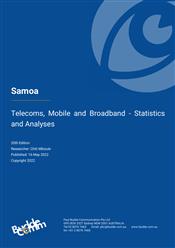Samoa Telecoms Market Report
Telecoms, Mobile and Broadband - Statistics and Analyses

Government to take control of Samoa Submarine Cable Company
Samoa was one of the first Pacific Island countries to establish a regulatory infrastructure and to liberalise its telecom market. In 2006, it became the first country in the region to see the market entrance of Digicel, which has since launched services in other Pacific nations. The advent of competition in the mobile market saw prices fall by around 50% and network coverage increase to more than 90% of the population. Samoa also boasts one of the highest rates of mobile phone coverage in the Pacific region.
LTE is developing on the back of an initial launch of the technology in 2016 by Digicel Samoa, followed by BlueSky Samoa (now Vodafone Samoa) in 2017. Digicel Samoa completed its LTE network in September 2020. However, the growth of fixed-line internet has been impeded by factors including the high costs for bandwidth, underinvestment in fixed-line infrastructure, as well as a strained consumer profile weighing on demand for services.
Digicel Samoa’s financially troubled parent company, Digicel Pacific, had been on the lookout for a potential buyer for several months as it struggled financially. After various Chinese firms registered interest in taking a stake, the Australian government sought to block further Chinese investment in the region by providing financial support for a local buyer. In October 2021, Telstra agreed to acquire Digicel Group’s Pacific operations for around $1.6 billion, with a financial input from the Australian government of around $1.33 billion.
Similar to other countries in the Pacific Islands, Samoa’s telecoms sector has been inhibited by a lack of international connectivity. While Samoa has had access to the Samoa-America-Samoa (SAS) cable laid in 2009, this cable has insufficient capacity to meet the country’s future bandwidth needs.
This issue was addressed with two new submarine cables that became available in 2018 and 2019. These, combined with the Samoa National Broadband Highway (SNBH), have improved internet data rates and reliability, and have helped to reduce the high costs previously associated with internet access in Samoa. In April 2022, the Samoan government announced its decision to take over control of the Samoa Submarine Cable Company, looking to the cable to generate additional revenue for the state.
On the consumer side, spending on telecoms services and devices is under pressure from the financial effect of large-scale job losses and the consequent restriction on disposable incomes brought on by the outbreak of the Covid-19 pandemic. This saw mobile and broadband connections decline during 2020. However, the crucial nature of telecom services, both for general communication as well as a tool for home-working, helped to offset such pressures. The market has since returned to growth, supported by an economic rebound in the country. The pandemic’s impact on the long-term outlook for the market is expected to be muted.
The report covers the responses of the telecom operators as well as government agencies and regulators as they react to the crisis to ensure that citizens can continue to make optimum use of telecom services. This can be reflected in subsidy schemes and the promotion of tele-health and tele-education, among other solutions.
Key developments:
- Samoan government announces its decision to take over control of the Samoa Submarine Cable Company.
- The Ministry of Communication and Information Technology is allocated ST$8.8 million in the 2022 Budget;
- Australian government contributes $1.33 billion of the $1.6 billion cost for Telstra to acquire Digicel Pacific;
- Manatua cable is ready for service.
Companies covered in this report include:
Amalgamated Telecom Holdings (ATH), Vodafone Samoa, Amper, Blue Sky Samoa, Digicel Samoa, Kacific Broadband Satellite, O3b.
Related Reports
- South Pacific Islands - Telecoms, Mobile and Broadband - Statistics and Analyses
- New Caledonia - Telecoms, Mobile and Broadband - Statistics and Analyses
- Papua New Guinea - Telecoms, Mobile and Broadband - Statistics and Analyses
- Solomon Islands - Telecoms, Mobile and Broadband - Statistics and Analyses
- Fiji - Telecoms, Mobile and Broadband - Statistics and Analyses
- Vanuatu - Telecoms, Mobile and Broadband - Statistics and Analyses
- French Polynesia - Telecoms, Mobile and Broadband - Statistics and Analyses
- Australia - Telecoms, Mobile and Broadband - Statistics and Analyses
Share this Report
TMT Intelligence
A platform to scale your intelligence tasks
Monitor critical insights with our AI-powered Market Intelligence Platform gathering and analyzing intelligence in real time. With AI trained to spot emerging trends and detect new strategic opportunities, our clients use TMT Intelligence to accelerate their growth.
If you want to know more about it, please see:
Research Methodology
BuddeComm's strategic business reports contain a combination of both primary and secondary research statistics, analyses written by our senior analysts supported by a network of experts, industry contacts and researchers from around the world as well as our own scenario forecasts.
For more details, please see:
More than 4,000 customers from 140 countries utilise BuddeComm Research
Are you interested in BuddeComm's Custom Research Service?
Hot Topics
News & Views
Have the latest telecommunications industry news delivered to your inbox by subscribing to BuddeComm's weekly newsletter.